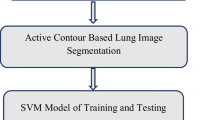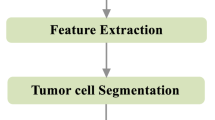Abstract
Suspicious volumetric tumor (SVT) segmentation of a CT-image (CT\(_{i}\)) and analysing changes in the volume of tumor is a significantly challenging task for the identification of lung cancer. In this regard, we design a two-step suspicious volumetric tumor segmentation (SVTS) approach based on an adaptive multiple resolution contour (AMRC) models for effective SVT segmentation. First, the high-intensity-pixels edge centroid of SVT (HECS) method is designed to identify the SVT location in CT\(_{i}\), and these outcomes are subsequently conceding threshold values to fix the level set method (LSM). Second, HECS outcomes are recognised using particle swarm optimisation (PSO) which is harmonised twin support vector machines (TSVM) to achieve segmentation accuracy. An open-source tumor cancer imaging archive (TCIA) dataset, 529 abnormal tissues (ATs) of the lung from the lung image database consortium (LIDC), are conceded to assess the performance of the SVT segmentation approach. The average segmentation accuracy of NLTC, TCIA, and LIDC datasets are 73.19%, 76.21% and 75.89%, respectively, compared with standard benchmark approaches. Subsequently, our framework efficiently classified the normal and abnormal CT\(_{i}\) based on the SVT segmentation accuracy rate.







Similar content being viewed by others
References
Zilong H, Tang J, Wang Z, Zhang K, Zhang L, Sun Q (2018) Deep learning for image-based cancer detection and diagnosis–a survey. Pattern Recognit 83:134–149
Ferlay J, Colombet M, Soerjomataram I, Parkin DM, Piñeros M, Znaor A, Bray F(2021) Cancer statistics for the year 2020: an overview. Int J Cancer
Chung-Feng JK, Kuan HL, Weng W-H, Barman J, Huang C-C, Chiu C-W, Lee J-L, Hsu H-H (2021) Complete fully automatic segmentation and 3-dimensional measurement of mediastinal lymph nodes for a new response evaluation criteria for solid tumors. Biocybern Biomed Eng 41(2):617–635
Ghaffari M, Sowmya A, Oliver R (2020) Automated brain tumor segmentation using multimodal brain scans: a survey based on models submitted to the brats 2012–2018 challenges. IEEE Rev Biomed Eng 13:156–168
Chen L, Bentley P, Mori K, Misawa K, Fujiwara M, Rueckert D (2018) Drinet for medical image segmentation. IEEE Trans Med Imaging 37(11):2453–2462
Chen C, Zhou K, Zha M, Qu X, Guo X, Chen H, Wang Z, Xiao R (2021) An effective deep neural network for lung lesions segmentation from Covid-19 CT images. IEEE Trans Ind Inform
Zhang M, Li H, Pan S, Lyu J, Ling S, Su S (2021) Convolutional neural networks-based lung nodule classification: a surrogate-assisted evolutionary algorithm for hyperparameter optimization. IEEE Trans Evolut Comput
Jena SR, George ST, Ponraj DN (2021) Lung cancer detection and classification with DGMM-RBCNN technique. Neural Comput Appl. https://doi.org/10.1007/s00521-021-06182-5
Vijh S, Gaurav P, Pandey HM (2020) Hybrid bio-inspired algorithm and convolutional neural network for automatic lung tumor detection. Neural Comput Appl 1–14
Pramod Kumar S, Latte Mrityunjaya V, Siri Sangeeta K (2020) Volumetric lung nodule segmentation in thoracic CT scan using freehand sketch. IET Image Process 14(14):3456–3462
Setio AA, Ciompi F, Litjens G, Gerke P, Jacobs C, Van Riel SJ, Wille MM, Naqibullah M, Sánchez CI, Van Ginneken B (2016) Pulmonary nodule detection in CT images: false positive reduction using multi-view convolutional networks. IEEE Trans Med Imaging 35(5):1160–1169
Jordan C, Kocher Madison R, Jeffrey W, Madalyn S, Stringer Natalie FC, Joseph S, Pooyan S, Puneet S, Saikiran R, Joseph SU et al (2021) Automated detection of lung nodules and coronary artery calcium using artificial intelligence on low-dose CT scans for lung cancer screening: accuracy and prognostic value. BMC Med 19(1):1–14
Shen W, Zhou M, Yang F, Yu D, Dong D, Yang C, Zang Y, Tian J (2017) Multi-crop convolutional neural networks for lung nodule malignancy suspiciousness classification. Pattern Recognit 61:663–673
Kailasam MS, Thiagarajan MD (2021) Detection of lung tumor using dual tree complex wavelet transform and co-active adaptive neuro fuzzy inference system classification approach. Int J Imaging Syst Technol 31(4):2032–2046
Woźniak M, Siłka J, Wieczorek M (2021) Deep neural network correlation learning mechanism for CT brain tumor detection. Neural Comput Appl. https://doi.org/10.1007/s00521-021-05841-x
Chahal PK, Pandey S (2021) A hybrid weighted fuzzy approach for brain tumor segmentation using MR images. Neural Comput Appl. https://doi.org/10.1007/978-981-13-9939-8_24
Rajan PG, Sundar C (2019) Brain tumor detection and segmentation by intensity adjustment. J Med Syst 43(8):1–13
Zhou T, Canu S, Vera P, Ruan S (2021) Latent correlation representation learning for brain tumor segmentation with missing MRI modalities. IEEE Trans Image Process 30:4263–4274
Aghamohammadi A, Ranjbarzadeh R, Naiemi F, Mogharrebi M, Dorosti S, Bendechache M (2021) TPCNN: Two-path convolutional neural network for tumor and liver segmentation in CT images using a novel encoding approach. Expert Syst Appl. https://doi.org/10.1016/j.eswa.2021.115406
Alhassan AM, Zainon WM (2021) Brain tumor classification in magnetic resonance image using hard swish-based relu activation function-convolutional neural network. Neural Comput Appl. https://doi.org/10.1007/s00521-020-05671-3
Jamal AT, Ishak AB, Abdel-Khalek S (2021) Tumor edge detection in mammography images using quantum and machine learning approaches. Neural Comput Appl. https://doi.org/10.1007/s00521-020-05518-x
Jiang H, Ma H, Qian W, Gao M, Li Y (2017) An automatic detection system of lung nodule based on multigroup patch-based deep learning network. IEEE J Biomed Health Inform 22(4):1227–1237
Sayan K, Kanta SJ, Kumar SP (2019) A new entropy-based approach for fuzzy c-means clustering and its application to brain MR image segmentation. Soft Comput 23(20):10407–10414
ALzubi JA, Bharathikannan B, Tanwar S, Manikandan R, Khanna A, Thaventhiran C (2019) Boosted neural network ensemble classification for lung cancer disease diagnosis. Appl Soft Comput 80:579–591
Lakshmanaprabu SK, Nandan MS, Shankar K, Arunkumar N, Gustavo R (2019) Optimal deep learning model for classification of lung cancer on CT images. Future Gener Comput Syst 92:374–382
Mohamed SP, Ishak DM, Burhanuddin MA (2020) Improved watershed histogram thresholding with probabilistic neural networks for lung cancer diagnosis for CBMIR systems. Multimed Tools Appl 79(23):17115–17133
Bansal G, Chamola V, Narang P, Kumar S, Raman S (2020) Deep3Dscan: Deep residual network and morphological descriptor-based framework for lung cancer classification and 3D segmentation. IET Image Process 14(7):1240–1247
Yan K, Tian L, Xueqiao P, Elvis SG, Qiao L, Junyi Z (2020) Unsupervised multi-discriminator generative adversarial network for lung nodule malignancy classification. IEEE Access 8:77725–77734
Xie Y, Zhang J, Xia Y (2019) Semi-supervised adversarial model for benign-malignant lung nodule classification on chest CT. Med Image Anal 57:237–248
Revathi J, Anitha J, Rizwan P, Manikandan R, Hemanth DJ, Gandomi AH (2021) Machine learning-based left ventricular hypertrophy detection using multi-lead ECG signal. Neural Comput Appl 33(9):4445–4455
Acknowledgements
This work was supported in part of Basic Science Research Programs of the Ministry of Education (NRF-2018R1A2B6005105) and in part by the National Research Foundation of Korea (NRF) grant funded by the Korea government (MSIT) (No. 2019R1A5A8080290).
Author information
Authors and Affiliations
Corresponding authors
Ethics declarations
Conflict of interest
There is no conflict of interest between the authors to publish this article.
Additional information
Publisher's Note
Springer Nature remains neutral with regard to jurisdictional claims in published maps and institutional affiliations.
Rights and permissions
About this article
Cite this article
Sathish, K., Narayana, Y.V., Mekala, M.S. et al. Efficient tumor volume measurement and segmentation approach for CT image based on twin support vector machines. Neural Comput & Applic 34, 7199–7207 (2022). https://doi.org/10.1007/s00521-021-06769-y
Received:
Accepted:
Published:
Issue Date:
DOI: https://doi.org/10.1007/s00521-021-06769-y




